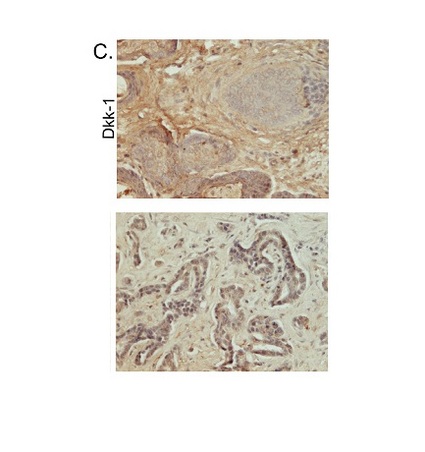
Image kindly provided by Dr. Magdalena Krol. Control tumor cells, tumor cells grown in macrophage-conditioned medium, tumor cells sorted from co-culture with macrophages, and macrophages from monocultures and sorted from co-culture with tumor cells were analyzed. Total protein concentrations in lysates were determined using a Bio-Rad protein assay. Proteins (50 mg) were resolved using SDS-PAGE and transferred onto PVDF membranes. The membranes were then blocked with 5% non-fat dry milk in TBS buffer containing 0.5% Tween 20. The membranes were then incubated overnight with the primary Rabbit Anti-DKK1 Polyclonal Antibody at 1:100 dilution. Subsequently, the membranes were washed three times in TBS containing 0.5% Tween 20 and incubated for 1 h at room temperature with secondary antibodies conjugated with the appropriate infrared (IR) fluorophore IRDyeH 800 CW or IRDyeH 680 RD at a dilution of 1:5000.
DKK1 Polyclonal Antibody
BS-2162R
ApplicationsImmunoFluorescence, Western Blot, ELISA, ImmunoCytoChemistry, ImmunoHistoChemistry, ImmunoHistoChemistry Frozen, ImmunoHistoChemistry Paraffin
Product group Antibodies
ReactivityCanine, Human, Mouse, Rat
TargetDKK1
Overview
- SupplierBioss
- Product NameDKK1 Polyclonal Antibody
- Delivery Days Customer16
- ApplicationsImmunoFluorescence, Western Blot, ELISA, ImmunoCytoChemistry, ImmunoHistoChemistry, ImmunoHistoChemistry Frozen, ImmunoHistoChemistry Paraffin
- Applications SupplierWB(1:300-5000), ELISA(1:500-1000), IHC-P(1:200-400), IHC-F(1:100-500), IF(IHC-P)(1:50-200), IF(IHC-F)(1:50-200), IF(ICC)(1:50-200)
- CertificationResearch Use Only
- ClonalityPolyclonal
- Concentration1 ug/ul
- ConjugateUnconjugated
- Gene ID22943
- Target nameDKK1
- Target descriptiondickkopf Wnt signaling pathway inhibitor 1
- Target synonymsDKK-1, SK, dickkopf-related protein 1, dickkopf 1 homolog, dickkopf-1 like, dickkopf-like protein 1
- HostRabbit
- IsotypeIgG
- Protein IDO94907
- Protein NameDickkopf-related protein 1
- ReactivityCanine, Human, Mouse, Rat
- Storage Instruction-20°C
- UNSPSC12352203
References
- Duan H, Yan Z, Chen W, et al. TET1 inhibits EMT of ovarian cancer cells through activating Wnt/β-catenin signaling inhibitors DKK1 and SFRP2. Gynecol Oncol. 2017,147(2):408-417. doi: 10.1016/j.ygyno.2017.08.010Read this paper




![WB analysis of HEK293 (1) and DKK1-hIgGFc transfected HEK293 cell lysate (2) using GTX83132 DKK1 antibody [2H2].](https://www.genetex.com/upload/website/prouct_img/normal/GTX83132/GTX83132_20170912_WB_w_23061322_869.webp)
